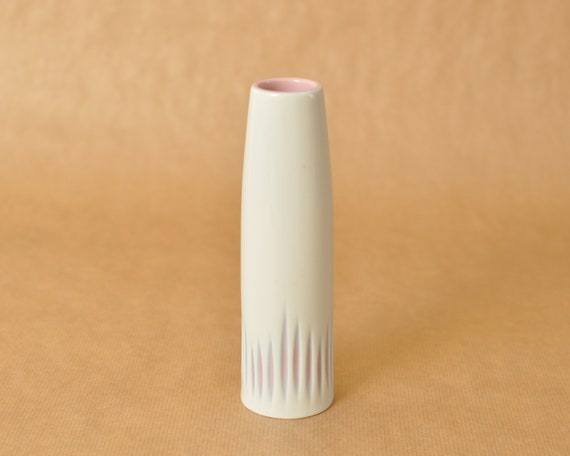Don't you love how
versatile the West-German vases are? They can be bold and colorful, Organic and
natural, but also sleek and elegant.
I also love it when
I find something new, something I have never found in the wild before. A few
weeks ago I was at a local thrift store that I don't visit often, because it is
about a 30 minute bike ride away. Even though it's far, I have found some great
things there (like a vintage Moschino blazer for 2 euros!), although not
necessarily a lot of vintage pottery.
This time, however,
I spotted the cutest little vase. A small, delicate but modern, white porcelain
vase with slashed details in pink and gray. I could see it had some age, and it
is stamped Sgrafo Modern.

The slashes in this
little vase reminded me of the paintings by Lucio Fontana.
In the past I have
had some elephants by Sgrafo, which were really cute. Like this vase, they
were really high quality porcelain: beautiful design, and nicely made.

Anyway, I decided to
bring the little vase home. Time for some research!
The West-Germany pottery
bible Keramik der 50er Jahre by Horst
Makus told me that this vase was designed by Peter Müller, who took over the Sgrafo
factory from his father, together with his brother, in 1955. On the website
sgrafo.blogspot.com I found some additional information about the slices in the
vase:
He developed a new technique of making porcelain […].
He put two, to three layers of porcelain (with varying colours) on top of one
another and then notched into the material. This method allowed the different
colors of the layers to become visible. This patented technique is called sgrafo, and he was the only one who realized it in the 50s and 60s.
Now, let's go back
to Lucio Fontana for a minute. In 1949 he started on what would later become
the series Buchi (holes) and Tagli (slashes): monochrome (mostly white or
gray) paintings with holes or slashes in the surface. He would often place a
dark layer on the reverse of the canvas, so the darkness would show through the
perforation. The Buchi started in 1949,
the Tagli in the mid-1950s.
Sounds sort of similar, right?
Now, I'm not saying
Peter Müller stole or even borrowed the idea from Fontana. In art and science
it often happens that similar ideas pop up around the same time. Personally, I
love that this happens! Even if the paintings were an inspiration, the sgrafo
vases are beautiful in their own right. (By the way, Lucio Fontano actually
made ceramics, and they are mostly very different,
much more organic! )
Sgrafo is no longer
in existence today. In 1995 Peter Müller retired. It was succeeded by the
company ASA who make stylish, often white, ceramic housewares.
Some browsing on
Etsy showed me that Sgrafo also made a wonderful little giraffe! I would love
to come across one of those!


